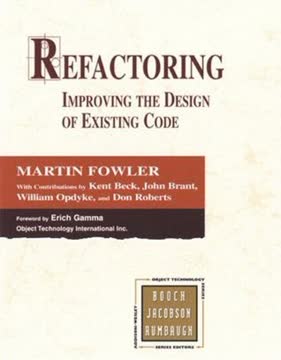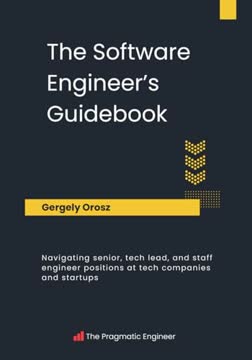Key Takeaways
1. Master Your Career Path: Navigate the Tech Industry Landscape
There's no single "good" career path.
Diverse opportunities abound. The tech industry offers various career paths, from startups to Big Tech, consultancies to traditional companies. Each environment presents unique challenges and opportunities for growth. Understanding these differences is crucial for making informed career decisions.
Compensation varies significantly. The industry follows a trimodal distribution of compensation packages:
- Tier 1: Local market rates (startups, small companies)
- Tier 2: Top of local market (some mid-sized tech companies, scaleups)
- Tier 3: Top of regional/international market (Big Tech, well-funded startups)
Career progression is not linear. While typical paths include individual contributor tracks and management tracks, many successful careers involve switching between roles, companies, and even industries. The key is to continuously learn and adapt to new challenges.
2. Own Your Professional Growth: Be Proactive in Development
Nobody cares about your career as much as you do.
Take ownership of your growth. Don't wait for your manager or company to guide your career. Actively seek opportunities for learning and advancement. This includes:
- Setting clear goals and communicating them to your manager
- Seeking feedback regularly from peers and leaders
- Keeping a work log to track accomplishments and learnings
- Identifying and addressing skill gaps
Build a support network. Cultivate relationships with mentors, both formal and informal. Seek out a "tech tribe" of mentors who can provide diverse perspectives and guidance:
- Dedicated mentor for regular check-ins
- Ad hoc mentors for specific challenges
- "Internet mentors" through blogs, books, and podcasts
Embrace continuous learning. The tech industry evolves rapidly, making lifelong learning essential. Dedicate time to:
- Mastering new programming languages and frameworks
- Understanding emerging technologies and industry trends
- Developing soft skills like communication and leadership
3. Excel in Getting Things Done: Prioritize and Communicate Effectively
Focus on the most important piece of work.
Prioritize ruthlessly. Identify your "#1 priority" - the single most important task that must be completed. Ensure this task gets done, even if it means saying no to other requests or delegating less critical work.
Communicate progress and challenges. Don't assume others understand the complexity or importance of your work. Regularly update stakeholders on:
- Progress made towards goals
- Challenges encountered and how you're addressing them
- The impact of your work on team and company objectives
Unblock yourself and others. Develop strategies for overcoming obstacles:
- Break down complex problems into smaller, manageable tasks
- Seek help from colleagues when stuck, but come prepared with what you've already tried
- Offer assistance to teammates facing challenges, fostering a collaborative environment
4. Code with Purpose: Write Clean, Maintainable Software
Readability is one of the most important characteristics of all code.
Prioritize code readability. Write code that is easy for others (and your future self) to understand and maintain. This includes:
- Using clear, self-explanatory variable and function names
- Keeping functions and classes focused on a single responsibility
- Adding comments to explain the "why" behind complex logic
Test thoroughly. Implement a comprehensive testing strategy:
- Unit tests for individual components
- Integration tests for system interactions
- End-to-end tests for complete user flows
- Consider the "testing trophy" approach, focusing on integration tests for maximum value
Refactor regularly. Don't let technical debt accumulate. Set aside time to improve existing code:
- Remove duplication and simplify complex logic
- Update outdated dependencies and patterns
- Improve performance and scalability as needed
5. Embrace Collaboration: Foster Teamwork and Effective Communication
Code reviews are the single most important quality control measure.
Master the art of code reviews. Approach reviews as a collaborative learning opportunity:
- Provide specific, actionable feedback
- Focus on both code quality and design decisions
- Be empathetic and constructive in your comments
- Use reviews as a chance to share knowledge and best practices
Communicate across disciplines. Build relationships beyond your immediate team:
- Engage with product managers to understand business goals
- Collaborate with designers to create better user experiences
- Work closely with ops teams to ensure smooth deployments
Foster a culture of knowledge sharing. Contribute to your team's collective wisdom:
- Document important decisions and lessons learned
- Share interesting articles, talks, or new technologies with colleagues
- Mentor junior team members and learn from senior engineers
6. Lead with Vision: Guide Projects and Teams to Success
The goal of stakeholder management is for the project to succeed by keeping everyone on the same page.
Set clear project goals and expectations. As a tech lead or project manager:
- Define and communicate the project's objectives and success criteria
- Break down large initiatives into manageable milestones
- Regularly assess progress and adjust plans as needed
Manage stakeholders effectively. Keep all relevant parties informed and aligned:
- Identify key stakeholders early in the project
- Tailor communication to each stakeholder's needs and interests
- Proactively address concerns and manage expectations
Foster a healthy team dynamic. Create an environment where team members can thrive:
- Encourage open communication and constructive feedback
- Recognize and celebrate individual and team achievements
- Address conflicts promptly and professionally
7. Understand the Business: Align Technical Decisions with Company Goals
Staff+ engineers are expected to be partners of EMs and PMs.
Develop business acumen. As you progress to senior and staff-level roles, understanding the business becomes crucial:
- Familiarize yourself with key performance indicators (KPIs) and objectives and key results (OKRs)
- Understand how your team's work contributes to overall company goals
- Stay informed about industry trends and competitive landscape
Partner with product and business teams. Collaborate closely to ensure technical decisions support business objectives:
- Participate in product strategy discussions
- Provide technical insights to inform business decisions
- Proactively identify opportunities for innovation and improvement
Think long-term. Balance immediate needs with long-term sustainability:
- Consider the scalability and maintainability of technical solutions
- Anticipate future business needs and build flexible systems
- Advocate for investments in infrastructure and developer productivity
Last updated:
FAQ
What's The Software Engineer's Guidebook about?
- Career Navigation Focus: The book provides insights into navigating software engineering roles, from entry-level to senior and staff positions, emphasizing understanding company cultures and expectations.
- Practical Advice: It offers practical advice on performance reviews, promotions, and job switching, helping engineers take ownership of their careers.
- Skill Development: Covers essential skills for software developers, including coding, collaboration, and project management, making it a comprehensive resource for professional growth.
Why should I read The Software Engineer's Guidebook?
- Real-World Insights: Written by Gergely Orosz, the book provides real-world insights that can help you navigate your career effectively.
- Structured Learning: Allows readers to focus on specific areas of interest, whether they are just starting out or looking to advance their careers.
- Timeless Advice: Captures observations and advice designed to stand the test of time, making it valuable for both current and future software engineers.
What are the key takeaways of The Software Engineer's Guidebook?
- Own Your Career: Emphasizes the importance of taking ownership of your career path, encouraging readers to actively seek growth opportunities.
- Understand Company Types: Categorizes different types of tech companies and their cultures, helping engineers choose the right environment for their career goals.
- Continuous Learning: Stresses the importance of lifelong learning and adapting to new technologies and methodologies in the fast-paced tech industry.
What are the best quotes from The Software Engineer's Guidebook and what do they mean?
- "No one cares about your career as much as you do.": Highlights the necessity for individuals to manage their career paths proactively.
- "The higher 'tier' a business is, the more tends to be expected of engineers.": Points out the varying expectations across different companies, especially between startups and Big Tech.
- "Software development is a craft that takes years to master.": Emphasizes the long-term commitment required to become proficient in software engineering.
How does The Software Engineer's Guidebook define career paths for software engineers?
- Single-Track vs. Dual-Track: Explains the difference between career paths that require a switch to management and those allowing growth as individual contributors.
- Common Career Progressions: Outlines typical progressions, such as moving from software engineer to senior engineer, and then to staff or principal engineer.
- Unique Paths: Discusses the variety of career paths, including specialization in technologies or transitioning into roles like product management.
What strategies does The Software Engineer's Guidebook suggest for getting things done?
- Prioritize Effectively: Advises identifying the most important tasks and focusing on completing them first to build a reputation for reliability.
- Unblock Yourself: Emphasizes recognizing when you are blocked and taking proactive steps to resolve issues.
- Break Down Work: Encourages breaking down larger tasks into manageable pieces to maintain productivity.
How does The Software Engineer's Guidebook address performance reviews?
- Preparation is Key: Stresses the importance of preparing for performance reviews by gathering context, setting goals, and keeping a record of achievements.
- Understanding the Process: Explains different performance review systems and how to navigate them effectively.
- Managing Expectations: Advises understanding your standing with managers and setting realistic expectations for outcomes.
What advice does The Software Engineer's Guidebook provide for promotions?
- Know the Criteria: Emphasizes understanding the specific criteria for promotions within your organization.
- Build Relationships: Highlights the need to cultivate relationships with managers and peers who can advocate for you.
- Be Realistic: Advises focusing on continuous improvement, regardless of whether a promotion is achieved in a given cycle.
How can I effectively switch jobs according to The Software Engineer's Guidebook?
- Explore Opportunities: Encourages actively exploring job opportunities, whether unhappy in the current role or curious about the market.
- Assessing Offers: Advises considering compensation, career growth potential, company culture, and challenges when evaluating job offers.
- Prepare for Interviews: Provides guidance on preparing for technical interviews, including understanding the process and practicing skills.
What role does continuous learning play in The Software Engineer's Guidebook?
- Lifelong Learning Emphasis: Stresses that continuous learning is essential for career growth as technologies evolve rapidly.
- Skill Development: Encourages mastering primary programming languages and exploring new technologies to stay relevant.
- Mentorship and Collaboration: Highlights the importance of seeking mentorship and collaborating with peers to enhance learning.
What is stakeholder management in The Software Engineer's Guidebook?
- Definition: Refers to identifying, engaging, and communicating with all parties interested in a project.
- Importance: Helps prevent misunderstandings and ensures relevant feedback is considered for smoother project execution.
- Methods: Suggests using meetings, asynchronous updates, and hybrid communication methods to keep stakeholders informed.
How does The Software Engineer's Guidebook define "team dynamics"?
- Healthy Teams: Describes healthy teams as those with clear goals, good morale, and effective communication.
- Unhealthy Teams: Contrasts with teams lacking clarity, experiencing poor execution, and struggling with communication.
- Improvement Strategies: Provides strategies for improving team dynamics, such as facilitating open discussions and addressing conflicts constructively.
Review Summary
The Software Engineer's Guidebook receives mixed reviews, with praise for its comprehensive coverage of software engineering careers and practical advice for junior to mid-level engineers. Critics note its broad but shallow approach, repetition, and lack of novel insights for experienced professionals. Many find it well-structured and valuable for career guidance, particularly for those early in their careers. Some readers appreciate its coverage of both technical and soft skills, while others feel it lacks depth on specific topics. Overall, it's considered a useful resource for understanding the software engineering career path.
Similar Books










Download PDF
Download EPUB
.epub digital book format is ideal for reading ebooks on phones, tablets, and e-readers.




